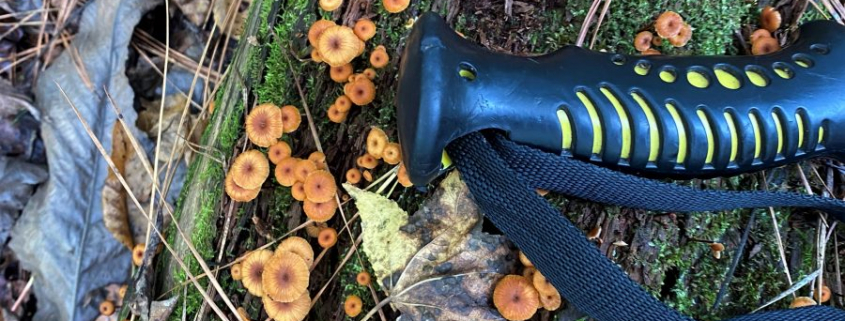Mid-October Fungi Ramble in The Wheeler National Wildlife Refuge Riparian Forests
October 22, 2021, the day after I measured 0.76″ of autumn rain, I couldn’t resist the siren’s song of the Wheeler National Wildlife Refuge riparian forest. Because mushrooms, some familiar and some not, greeted me in abundance, I focused my attention on admiring their diversity, beauty, and role in the forest’s dance of life and death. Fungi are the forest’s primary decomposers, along with bacteria and invertebrates. Forest organic matter transits continuously across time…within the soil; in the mass of living trees; in the flux of leaves and fine roots that senesce, breakdown, and reincorporate annually; in the downed woody debris that more slowly breaks down; and in the decomposer organisms themselves.
Mushrooms are the fleshy (not always) spore-bearing reproductive structures of fungi. Without their presence above ground or on the surface of their woody, decaying food sources, fungi would busy themselves within the decaying host or, in the case of mycorhizae, on or within the fine roots of commensual plants…invisible to hikers, naturalists, or poets who frequent our forests.
Most fungi spores are wind-born. A University of Hawaii online reference reported that Ganoderma applanatum, the artist fungus (also native to north Alabama), which has a perennial fruiting body (a conk), may disperse 5.4 trillion spores over a six month period. The same reference said that a typical cubic meter of air may contain 10,000 – 20,000 spores. Blown to within 30 degrees of horizontal, the hickory below is not yet dead, but is certainly weakened and in distress. Imagine the millions of spores that have already found its surface…seeking an entrance court to begin the infection and decay cycle.
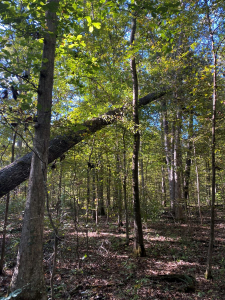
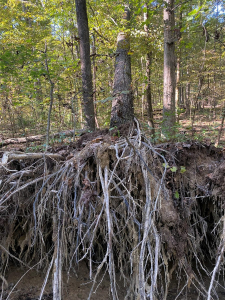
Standing death accommodates oak bracket fungi sustenance. How much longer will this snag maintain structural integrity before it crashes to the forest floor?! The cycle is endless. The forest sequesters carbon, yet it does not have unlimited storage capacity. Eventually these riparian forests reach an equilibrium, when they create and store carbon at a rate equal to decay, return to soil, and recycling within the always renewing forest.
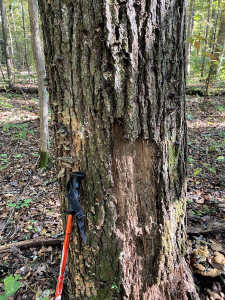
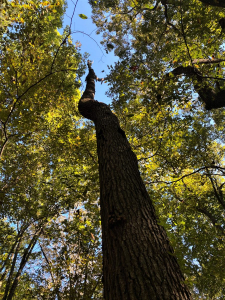
Although I don’t normally like to cite Wikipedia, sometimes that source offers the simplest descriptions: Inonotus dryadeus (syn. Pseudoinonotus dryadaeus), commonly known as oak bracket, warted oak polypore, weeping polypore, or weeping conk, is an inedible species of fungus belonging to the genus Inonotus, which consists of bracket fungi with fibrous flesh. Most often found growing at the base of oak trees, it causes white rot and decay of the trunks. It secretes an amber liquid which weeps from tubes in its upper surface.
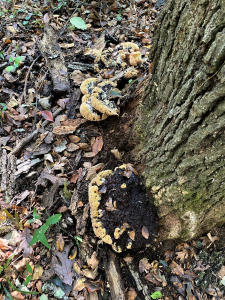
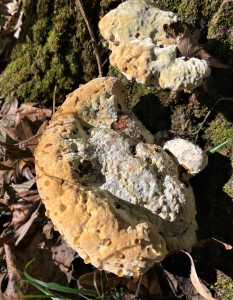
This colony of pinewood gingertails occupies a well decayed, moss-covered length of woody debris. The literature indicates that this species is not poisonous, but is bitter with no value as an edible.
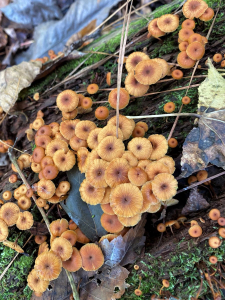
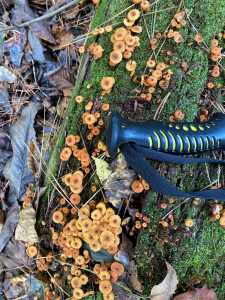
I failed to identify this loblolly pinecone mushroom. So, I shall dub it the loblolly pinecone fungus! I am sure that it, in fact, has a name.
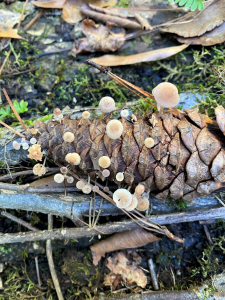
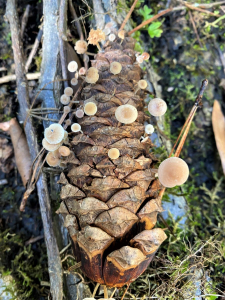
The iNaturalist app identified this as common funnel, Infundibulicybe gibba. However, when I dug into my various books and online references my confidence waned. I have so much to learn. For the moment, I will stay with the common funnel moniker.
Infundibulicybe gibba (also known as Clitocybe gibba) is a hardwood mushroom that features a pinkish-tan cap that becomes fairly deeply vase-shaped by maturity. Its pale, crowded gills run down the stem, which is pale in comparison to the cap. It grows solitary or in small troops on the soil in broad-leaf woods (iNaturalist).
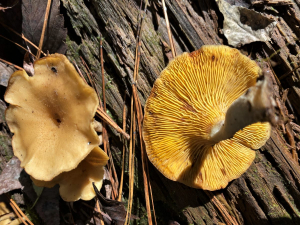
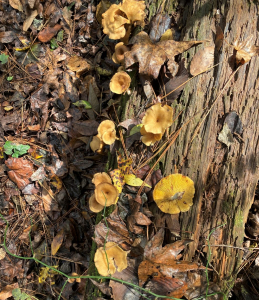
In contrast, I am confident that this more distinctive fungus is coral pink merulius, a lovely bit of color on the otherwise barren forest floor.
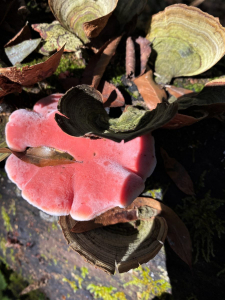
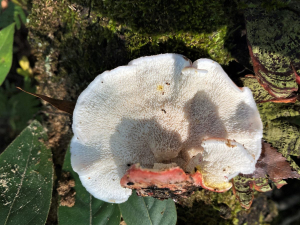
Here are two edibles for which I have identification confidence: ringless honey and oyster.
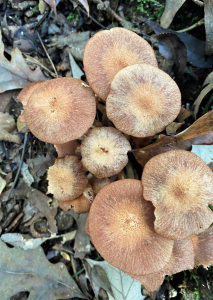
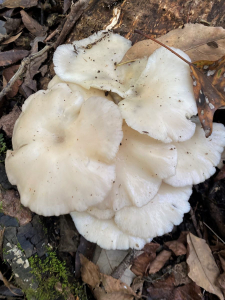
This coral-toothed fungus, about three inches end-to-end, is the first one I’ve encountered. Its structure reminded me of lion’s mane. Like lion’s mane, coral-toothed fungus is considered a culinary delight when young, white, and soft.
Coral Tooth Fungus is one of many irregular clump fungus species, arising from a basal attachment with multiple coral-like branches, ending in fine pendant comb-like spines branching from a central point, 50-200 mm wide. Entire fruiting body white to cream and surfaces smooth (projectnoah.org).
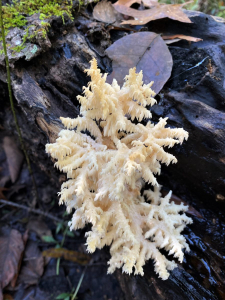
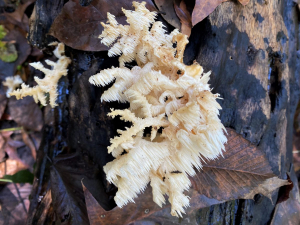
This lion’s mane, the only one I spotted during this hike, is about four inches across and is already yellowing. I must apologize for the poor quality photo. I can offer no excuse. Lion’s mane and coral-toothed musrooms are aesthetic marvels. I love their clean luster and complex toothed structure. I would enjoy seeing them even if they were inedible!
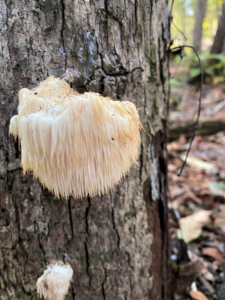
A New Plant for Me
I discovered several small patches of sparse-lobed grapefern or southern grapefern. I know that I’ve seen them before, yet had not taken the time to identify. These specimens had recently produced fertile fronds extending well above the leaves.
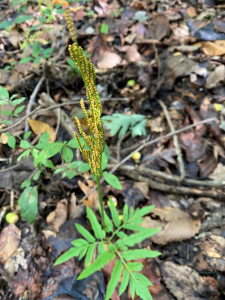
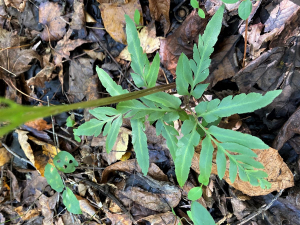
I think back fifty-plus years when I spent many an October afternoon hunting squirrels in the central Appalachians. I considered myself an avid outdoorsman, yet I cannot dredge up a single memory of noticing mushrooms. Today I still watch for the bushytails. I no longer hunt, but I do enjoy watching them forage and frolick both on ground and within the canopy. However, they are not my primary focus. I am not sure I have a primary focus most days. Instead, I look for all manner of beauty and curiosity hiding in plain sight as I wander the forest. This day, I admit, because the forest seemed rich with them, mushrooms drew my attention. I was not foraging for edibles. My camera served as my collecting bucket.
Thoughts and Reflections
I offer these observations:
- Fungi are the forest’s primary decomposers, along with bacteria and invertebrates.
- Organic matter transits within the forest across time — in living and dead tissue, and in the soil.
- Occasionally, focus your woods-walk attention on forest fungi: their diversity, beauty, and role in the forest’s dance of life and death.
Inhale and absorb Nature’s elixir. May Nature Inspire, Inform, and Reward you!
Note: All blog post images created & photographed by Stephen B. Jones unless otherwise noted. Please circulate images with photo credit: “©2022 Steve Jones, Great Blue Heron LLC. All Rights Reserved.”
Another Note: If you came to this post via a Facebook posting or by an another route, please sign up now (no cost… no obligation) to receive my Blog Post email alerts: http://eepurl.com/cKLJdL
And a Third: I am available for Nature-Inspired Speaking, Writing, and Consulting — contact me at steve.jones.0524@gmail.com
Reminder of my Personal and Professional Purpose, Passion, and Cause
If only more of us viewed our precious environment through the filters I employ. If only my mission and vision could be multiplied untold orders of magnitude:
Mission: Employ writing and speaking to educate, inspire, and enable readers and listeners to understand, appreciate, and enjoy Nature… and accept and practice Earth Stewardship.
Vision:
- People of all ages will pay greater attention to and engage more regularly with Nature… and will accept and practice informed and responsible Earth Stewardship.
- They will see their relationship to our natural world with new eyes… and will understand more clearly their Earth home.
Tagline/Motto: Steve (Great Blue Heron) encourages and seeks a better tomorrow through Nature-Inspired Living!
Steve’s Three Books
I wrote my books Nature Based Leadership (2016), Nature-Inspired Learning and Leading (2017), and Weaned Seals and Snowy Summits: Stories of Passion for Place and Everyday Nature (2019; co-authored with Dr. Jennifer Wilhoit) to encourage all citizens to recognize and appreciate that every lesson for living, learning, serving, and leading is either written indelibly in or is powerfully inspired by Nature.
I began writing books and Posts for several reasons:
- I love hiking and exploring in Nature
- I see images I want to (and do) capture with my trusty iPhone camera
- I enjoy explaining those images — an educator at heart
- I don’t play golf!
- I actually do love writing — it’s the hobby I never needed when my career consumed me
- Judy suggested my writing is in large measure my legacy to our two kids, our five grand kids, and all the unborn generations beyond
- And finally, perhaps my books and Blogs could reach beyond family and touch a few other lives… sow some seeds for the future


All three of my books (Nature Based Leadership; Nature-Inspired Learning and Leading; Weaned Seals and Snowy Summits) present compilations of personal experiences expressing my (and co-author Dr. Wilhoit for Weaned Seals and Snowy Summits) deep passion for Nature. All three books offer observations and reflections on my relationship to the natural world… and the broader implications for society. Order any and all from your local indie bookstore, or find them on IndieBound or other online sources such as Amazon and LifeRich.

